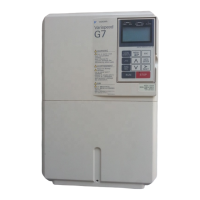Protective and Diagnostic Functions
7-5
Inverter’s Cooling Fan Fault
An Inverter’s cooling fan fault was
detected, and the Inverter-overload
protection was activated based on the
internal electric thermal value.
This fault is detected when L8-32 is
set to 0.
The Inverter continued running with
an overload after the cooling fan
stopped.
Replace the cooling fan. (Contact
our sales representative.)
Motor Overheating Alarm
The Inverter will stop or will continue
to operate according to the setting of
L1-03.
The motor has overheated.
Check the size of the load and the
length of the acceleration, deceler-
ation, and cycle times.
Check the V/f characteristics.
Check the motor temperature
input on terminals A2 .
Check the setting of E2-01 (motor
rated current).
Motor Overheating Fault
The Inverter will stop according to the
setting of L1-04.
The motor has overheated.
Check the size of the load and the
length of the acceleration, deceler-
ation, and cycle times.
Check the V/f characteristics.
Check the motor temperature
input on terminals A2 .
Check the setting of E2-01 (motor
rated current).
Installed Braking Resistor Over-
heating
The braking resistor is overheated and
the protection function has operated if
it has been enabled in L8-01.
The deceleration time is too short and
the regenerative energy from the
motor is too large.
• Reduce the load, increase the
deceleration time, or reduce the
motor speed.
• Change to a Braking Resistor
Unit.
Internal Braking Transistor Fault
The braking transistor is not operating
properly.
• The braking transistor is damaged.
• The Inverter’s control circuits are
faulty.
• Try turning the power supply
off and on.
• Replace the Inverter if the fault
continues to occur.
Motor Overload
The motor overload protection func-
tion has operated based on the internal
electronic thermal value.
The load is too heavy. The accelera-
tion time, deceleration time, and cycle
time are too short.
Check the size of the load and the
length of the acceleration, deceler-
ation, and cycle times.
The constant setting for speed search
is incorrect.
(Motor overload occurred due to
motor hunting and vibration.)
• Use the speed search function.
• Adjust the settings of the Speed
search operating current (b3-02)
and Speed search deceleration
time (b3-03).
• Use the estimated speed search
function. (Perform stationary
autotuning for line-to-line resis-
tance only.)
• Motor overload occurred when run-
ning at low speed. (If a general-pur-
pose motor is used, motor overload
can occur when running at low
speed even if running within the
rated current.)
• Motor protection selection (L1-01)
is set to general-purpose motor pro-
tection (1) when an Inverter duty
motor is used.
• Check the size of the load.
• Check the setting of L1-01.
• Increase the frame size of the
Inverter.
Table 7.1 Fault Displays and Processing (Continued)
Display Meaning Probable Causes Corrective Actions
and A3
and A3

